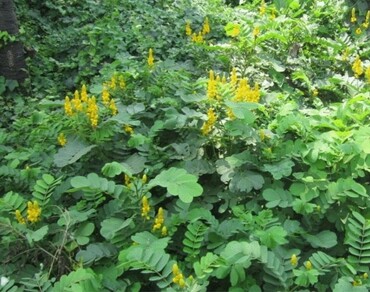Phytotoxic effects of aqueous leaf extract of Senna alata on seed germination and biochemical changes in Vigna radiata L.
Veeraragavan Savitha, Natarajan Lakshminarayanan, Duraisamy Ramamoorthy, Chauhan Anita
Research Articles | Published: 19 February, 2022
First Page: 788
Last Page: 795
Views: 3868
Keywords: Senna alata L., Allelopathy-radicle length, Vigna radiata , Anti-oxidative, Enzymes
Abstract
The phytotoxicity property of aqueous leaf extract of an invasive plant Senna alata L. on germinating seeds of green gram Vigna radiata was evaluated using ANOVA and found to be significant at 0.05% level. The reduced against concentration gradient and phyto-toxicity index of the extract showed increasing trend; and both factors indicate concentration dependent activity. The stress enzymes amylase and invertase showed decreasing trend, whereas protease showed an increasing trend with coefficient of determination (r2 ) values of 0.88, 0.95 and 0.94 confirming phytotoxicity of extract on germinating seeds of Vigna radiata as highly significant. Estimation of anti-oxidative stress by extract treated germinating seeds showed increasing H2O2 production, SOD activity and FRAP activity. The experimental study demonstrated that the invasive plant Senna alata possesses phytotoxic properties which may be instrumental in weed management through lab-to-land programme. The study also showed that the increased enzyme activity can inhibit the seedling growth and therefore, could be used to suppress the growth of different weeds in crop fields.

References
Apel K, Hirt H (2004) Reactive oxygen species: metabolism, oxidative stress, and signal transduction. Annu Rev Plant Biol 55:373–399
Benzie IF, Strain JJ (1996) The ferric reducing ability of plasma (FRAP) as a measure of “antioxidant power”: the FRAP assay. Anal Biochem 239(1):70–76
Bernfeld P (1955) Alpha and beta amylases. Methods Enzymol 1:149–158
Chiou CH, Muller CH (1972) Allelopathic mechanism of Archtostaphylous glandulosa variety Zazaeisis, American. Mideterian Nat 88:324–347
Das KR, Iwasaki A, Suenaga K, Kato-Noguchi H (2019) Evaluation of phytotoxic potential and identification of phytotoxic substances in Cassia alata Linn. leaves. Acta Agric Scand Sect B Soil Plant Sci 69(6):479–488
Dorman HD, Koşar M, Kahlos K, Holm Y, Hiltunen R (2003) Antioxidant properties and composition of aqueous extracts from Mentha species, hybrids, varieties, and cultivars. J Agric Food Chem 51(16):4563–4569
Douglas CJ (1996) Phenylpropanoid metabolism and lignin biosynthesis: from weeds to trees. Trends Plant Sci 1(6):171–178
Dubey RS (1999) Protein synthesis by plants under stressful conditions. In: Pessarakli M (ed) Handbook of plant and crop stress 2. Marcel Dekker, New York, pp 365–397
El-Shora HM, Abdel-Aal M, Ibrahim FF (2015) Allelopathic potential of Trichodesma africanum L.: Effects on germination, growth, chemical constituents and enzymes of Portulaca oleracea L. Int J Curr Microbiol Appl Sci 4(9):941–951
Findura P, Hara P, Szparaga A, Kocira S, Czerwińska E, Bartoš P, Treder K (2020) Evaluation of the effects of allelopathic aqueous plant extracts, as potential preparations for seed dressing, on the modulation of cauliflower seed germination. Agriculture 10(4):122
Gill SS, Tuteja N (2010) Reactive oxygen species and antioxidant machinery in abiotic stress tolerance in crop plants. Plant Physiol Biochem 48(12):909–930
Gomez JM, Jimenez A, Olmos E, Sevilla F (2004) Localization and effects of long-term NaCl stress on superoxide dismutase and ascorbate peroxidase isoenzymes of pea (Pisum sativum cv. Puget) chloroplasts. J Exp Bot 55:119–130
Gulzar A, Siddiqui MB, Bi S (2014) Assessment of allelopathic potential of Cassia sophera L. on seedling growth and physiological basis of weed plants. Afr J Biotechnol 13(9):1037–1046
Gupta AS, Webb RP, Holaday AS, Allen RD (1993) Overexpression of superoxide dismutase protects plants from oxidative stress (induction of ascorbate peroxidase in superoxide dismutase-over expressing plants). Plant Physiol 103(4):1067–1073
Harris GP, Jeffcoat B (1974) Effects of temperature on the distribution of 14C-labelled assimilates in the flowering shoot of carnation. Ann Bot 38(1):77–83
Hierro JL, Callaway RM (2003) Allelopathy and exotic plant invasion. Plant Soil 256(1):29–39
Hussain MI, El-Sheikh MA, Reigosa MJ (2020) Allelopathic potential of aqueous extract from Acacia melanoxylon R. Br. on Lactuca sativa. Plants 9(9):1228
Ighosotu S, Tonukari NJ (2013) The effects of Senna alata L. aqueous leaf extract on the germination of Corchorus olitorius. J Agric Biotechnol Sustain Dev 5(1):1
James JF, Bala R (2003) Allelopathy: How plants suppress other plants. IFAS, University of Florida, Gainesville
Kazinczi G, Béres I, Hunyadi K, Mikulás J, Polos E (1991) A selyemmályva (Abutilon theophrasti Medic.) allelopatikushatásánakéskompetitívképességénekvizsgálata. Növénytermelés 40:321–331
Keating KI (1999) Allelopathy: principles, procedures, processes, and promises for biological control. Adv Agron 67:141–231
Ladd JN, Butler JHA (1972) Short-term assays of soil proteolytic enzyme activities using proteins and dipeptide derivatives as substrates. Soil Biol Biochem 4(1):19–30
Lockwood JL, Hoopes MF, Marchetti MP (2013) Invasion ecology. Wiley, New York
Madane Atul N, Patil BJ (2017) Studies in allelopathic effect of Eupatorium odoratum L. on amylase activity during seed germination of Cicer arietinum L. and Cajanus cajan (L.) Millsp. Biosci Discov 8(1):82–86
Maharjan S, Shrestha BB, Jha PK (2007) Allelopathic effects of aqueous extract of leaves of Parthenium hysterophorus L. on seed germination and seedling growth of some cultivated and wild herbaceous species. Sci World 5(5):33–39
Mooney HA (2005) Invasive alien species: a new synthesis, vol 63. Island Press, Washington
Author Information
Department of Ecology and Environmental Sciences, Pondicherry University, Puducherry, India